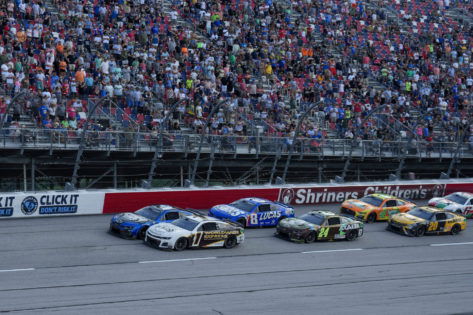NASCAR has long struggled to keep races exciting while staying true to the sport’s roots. Back in 2016, the Truck Series introduced the controversial “Caution Clock.” This rule forced a caution every 20 minutes if one hadn’t occurred naturally. Many drivers, like Kyle Petty, were outspoken in their criticism. Petty argued that such rules undercut the hard-earned advantages built over green-flag runs. “This is not football, not basketball, not baseball… You get somebody down; you keep them down. You don’t let them back in. NASCAR has a rule that allows everybody to catch up. So, what’s the point in trying to outrun and beat everybody that bad?” Petty said.
NASCAR designed the clock to prevent long green-flag stretches from making races dull. Instead, it sparked backlash. By trying to fix a perceived problem, NASCAR created a bigger one: fans felt the drama was manufactured. The fallout from the caution clock led NASCAR to pivot in 2017 to a new format, stage racing. Stage racing splits events into three segments, each with its own conclusion and set of points. The move was aimed at keeping fans engaged and broadcasters happy. But it was sort of the new rendition of he caution clock, only with the addition of the points.
From the beginning, some fans and drivers worried that these changes prioritized spectacle over sport. Now, nearly eight years later, fans are again demanding a shift. This time, they want NASCAR to steer away from pre-planned drama and let races unfold naturally. What was once a controversial fix may now need fixing itself.
NASCAR’s All-Star gamble triggers fans!
This time, the debate reignited after NASCAR’s announcement for the All-Star Race. They confirmed a promoter’s caution would be used to bunch up the field around lap 200 of a 250-lap spectacle. For fans already uneasy about stage cautions, this was the tipping point. Many took to social media to express their frustration. To them, the move went against the original promise of stage racing, replacing random cautions with structured competition.
The backlash grew fast. Many called it a step backwards, arguing it undermines the entire point of stage racing. After all, stage cautions were introduced to provide structure and eliminate randomness. Now, NASCAR is reviving the idea of “entertainment-first” cautions, exactly what fans had criticized in the past. One fan commented, “Stage cautions don’t make a great race better, nor do they make a worse race any better. They hurt, rather than help, even more so in the lower series with shorter races.”
LOS ANGELES, CA – FEBRUARY 05: While under caution near the end of the race, Bubba Wallace (No. 23, 23XI Racing DoorDash Toyota) tried to block Austin Dillon (No. 3, Richard Childress Racing Get Bioethanol Chevrolet) after Dillon spun him into the wall in Turn 2 during the NASCAR Cup Series Busch Light Clash at The Coliseum on February 5, 2023, at the Los Angeles Memorial Coliseum. Photo by Chris Williams/Icon Sportswire AUTO: FEB 05 NASCAR Cup Series Busch Light Clash at The Coliseum Icon0072302051215
This sentiment resonated with others who believe that the constant resetting of the field strips races of their natural ebb and flow. The issue isn’t just philosophical, it’s practical too. Statistics show that the length of stage-end cautions has quietly become one of the biggest complaints among fans and teams. According to Building Speed, since stage racing began in 2017, caution lengths have crept upward. In 2021, the average caution lasted 5.29 laps.
That number jumped to 6.41 in 2023. But 2025 has seen a notable spike, with stage cautions now averaging 7.39 laps each (for races concluded till April 4th). NASCAR has already seen 13 stage-end cautions this year. Three of them lasted 10 laps or longer, with Martinsville topping the list at 12 laps. That caution came when officials took extra time to clean marbles, small rubber bits, off the racing surface. Phoenix saw two other long ones due to softer tires, which create more marbles and require extra cleanup.
That raises an important question: do fans want better grip and more tire falloff, or shorter breaks and less downtime? There’s no clear answer, but the issue is growing louder. Interestingly, if NASCAR removed the three longest cautions this year, the average would drop to 6.3 laps, which is close to normal. Still, for a sport built on speed and flow, long pauses break the rhythm. Fans are now wondering if the trade-off is still worth it.
However, inside the garage, opinions are split. Some drivers, like Denny Hamlin, argue that stage racing improved the sport. “It was well thought out. The points system is good,” he said in 2023. Others, like Michael McDowell, see it as artificial. “Indoor karting is entertaining too. But is that what the fans really want?” he had said. Stage racing clearly has its pros.
It gives drivers more chances to earn points, boosts mid-race engagement, and offers guaranteed commercial slots for TV partners. But its cons, predictability, long cautions, and a perceived loss of authenticity, are now taking center stage. As fans push for more natural racing, the question now becomes: Is NASCAR listening?
Fans want real racing!
The debate around stage cautions has boiled over into passionate fan reactions. Many are fed up with what they see as overly manufactured moments and are calling for NASCAR to let the races breathe. One user on Reddit explained the core issue, saying, “The caution is a major point of the stages. 1) Gives TV built-in commercial time. 2) Creates restarts. 3) Bunches up the field. Not saying I don’t agree with you, just saying it’s a major factor in what they really want to accomplish with the stage. Also, I’d rather know as a competitor there are cautions at lap X and Y than at random back in the ‘debris caution’ days.”
This comment reflects a nuanced take. Some fans recognize the commercial and strategic reasons behind stage cautions. But they also long for the purity of competition over engineered chaos. Another echoed the sentiments and said, “Removing the stage cautions fixes the fuel-saving nonsense at superspeedways. Get to the end the fastest. Maybe there are alternative strategies worth trying that involve saving fuel, but I’d rather see the different strategies play out rather than everyone just riding around at slow speeds.”
These opinions, backed by fact, echo frustration seen across online discussions. In shorter races, especially, these scheduled interruptions feel excessive, preventing any real flow or rhythm. Others worry about unintended consequences. One user said, “What everyone is forgetting when they say ‘do away with stage cautions’ is that there will still be the same amount of cautions. Now, they’ll just be phantom debris cautions instead of planned out.” We all know what happened with Carl Edwards during the championship race back in 2016. A debris caution late in the race at Homestead derailed his championship run and perhaps forced him close to his retirement decision.
It’s a valid point. The fear is that removing stage breaks might just open the door for vague, unexplained cautions instead. Still, for many, this is a risk worth taking. One of the most poignant comments hit at the core of the debate: “Couldn’t agree more, imagine any other sport that reset the score every quarter to keep the game interesting.” This analogy stuck with fans. It underscores the problem: race outcomes shouldn’t hinge on resets. What is the point if a driver carves up a six-to-ten-second lead over the rival during the race, only to be stacked up again on a restart?
The post NASCAR Fans Raise Voice Against Age Old Controversy, Demands Authenticity Over Made-for-TV Moments appeared first on EssentiallySports.



